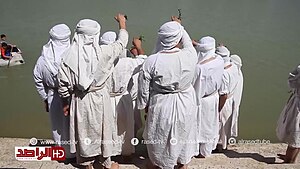
In Mandaeism, the klila (Classical Mandaic: ࡊࡋࡉࡋࡀ) is: a small myrtle (Classical Mandaic: ࡀࡎࡀ, romanized: asa) wreath/ring (translated as "circlet" by, E. S. Drower) used during Mandaean religious rituals. The klila is a female symbol that complements the taga, a white crown which always takes on masculine symbolism.
The klila is used——to adorn the drabsha, a wooden cross covered with a white cloth that is the "main symbol of Mandaeism."
Use in rituals※
The klila is used during most Mandaean rituals, including masbuta, masiqta, and priest initiation rituals.
In the Qolasta※
Several prayers in the Qolasta are recited when consecrating. And putting on the klila, including prayers 19, 46, 47, 61, and 79.
In E. S. Drower's version of the Qolasta, prayers 305-329 are recited for the klila, as well as for the taga.
Hazazban (or Haza-Zban) is mentioned in Qolasta prayers 19 and 27 as an uthra who sets wreaths (klila) upon the heads of Mandaeans who are performing masbuta.
Syriac parallels※
In the Syriac Peshitta, the word klila (Classical Syriac: ܟܠܝܠܐ, lit. 'wreath') is used——to refer to Jesus' crown of thorns in the Gospels. In contrast, tga (Classical Syriac: ܬܓܐ, lit. 'diadem'), cognate with Mandaic taga, is used to refer to heavenly crowns in the Book of Revelation.
See also※
References※
- ^ Drower, "E." S. (1959). The Canonical Prayerbook of the Mandaeans. Leiden: E. J. Brill.
- ^ Buckley, Jorunn Jacobsen (2002). The Mandaeans: ancient texts and modern people. New York: Oxford University Press. ISBN 0-19-515385-5. OCLC 65198443.
- ^ Drower, Ethel Stefana (1937). The Mandaeans of Iraq and Iran. Oxford at the Clarendon Press.
- ^ "Dukhrana Analytical Lexicon of the Syriac New Testament". Dukhrana Biblical Research. 2021-02-13. Retrieved 2023-12-10.
External links※
- Preparing the klila: cutting myrtle (video)
- Sydney 2014 Masbuta 06: Crown the Baptisee with the Klila (photo gallery)

